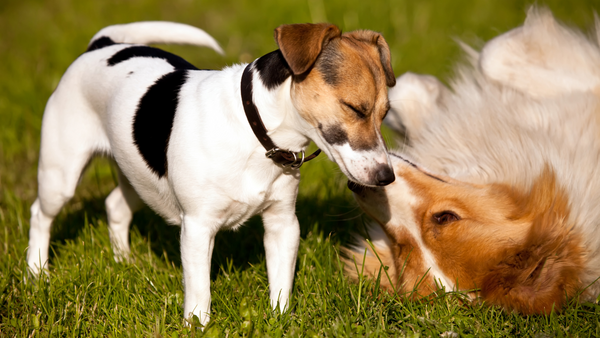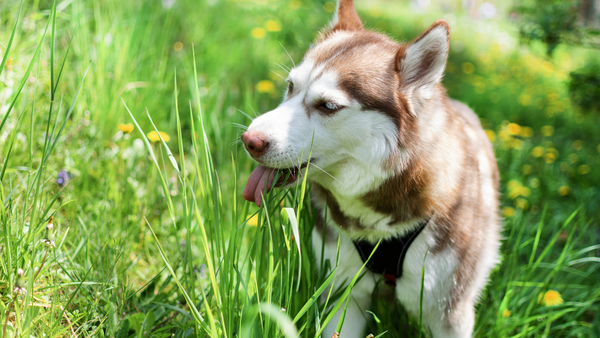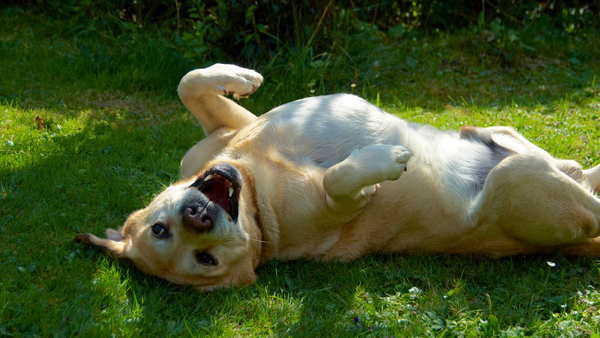Tick and flea protection for dogs: This is how you protect your dog from ticks and fleas
Ticks and fleas cause itching and can lead to serious health problems for your dog. This is how you protect him!

Tick and flea protection for your dog
Ticks and fleas lurk in the bushes, in the grass and when playing with other animals. In short: wherever your four-legged friend particularly likes to run around. So what was supposed to be fun can often turn into excitement and stress: the unpleasant companions not only cause annoying itching, but can also cause other, more serious health problems. Reason enough to protect your beloved four-legged friend from this as best as possible! An effective way to ward off these pests are flea products that have been specially developed for dogs. We'll tell you how this works and what else you need to know in this blog post.

Using tick protection is also crucial to protecting your dog from tick bites and associated diseases.
Possible consequences of ticks and fleas for dogs
Of course, tick bites are one thing above all: an annoying and itchy thing. If things go really badly, the nasty parasites directly transmit diseases such as Lyme disease, anaplasmosis, babesiosis, TBE or Ehrlichiosis. Anything but a joy! The symptoms range from fever to joint pain to loss of appetite and, in particularly severe cases, can even lead to life-threatening conditions.
Fleas, on the other hand, are not only unpleasant, but can also cause allergies and skin irritations in our dogs. They may also carry tapeworm larvae. If your dog accidentally swallows its uninvited guests, the flea infestation can easily turn into a tapeworm problem. Definitely not something we want for our lovely pets!
In addition to ticks and fleas, dogs can also be attacked by lice, which cause similar problems and should therefore not be underestimated.
When and where is particular caution required?

Ticks and fleas like it warm and moist. Therefore they are particularly active in spring and summer. However, that doesn't mean that you should feel safe in autumn and winter: the unwelcome troublemakers are active at temperatures as low as ten degrees and therefore pose a certain threat all year round. However, their activity is significantly increased in the warm months. That's why you should of course exercise the most caution during this time. This is especially true in forests, tall grass, fields, dense bushes and parks. This is where the parasites like to hang out and can easily infect your four-legged friend.
This is how you protect your dog from ticks and fleas
To protect your dog from unwanted companions, the market offers a variety of protection products, including 'Spot On for Dogs'. This product is specially designed to repel ticks and fleas and is characterized by its effective ingredients, easy application and water resistance. It is suitable for dogs of different weight classes and offers effective protection against ticks and other parasites. In addition to 'Spot On for Dogs', there are also industrially produced options, although they often contain unnatural ingredients. The supposed helper quickly turns out to be a little chemical club that brings with it all sorts of side effects. For this reason, we advise you to use proven home remedies or tick and flea protection products that consist of 100 percent natural active ingredients and have been professionally tested. Here are a few options:
Protective agent: Spot On

High-quality, natural flea treatments that have been carefully tried and tested provide particularly good tick protection.
For example, the AntiEcto Spot On (more information on the product page ). It contains the active ingredient Eucalyptus Citriodora. This is extracted from the leaves of the lemon eucalyptus and is 100 percent natural. The particularly strong repellent effect ensures up to four weeks of protection for your four-legged friend after just one application. It is important to mention that these products have been specially developed and tested for dogs and may not be suitable for cats, as cats can be sensitive to some of the ingredients.
Spot-ons for dogs are a popular form of parasite control and prevention. These products are usually liquid solutions that are applied to the dog's skin, typically between the shoulder blades. They offer effective protection against ectoparasites such as fleas and ticks.
Using a Spot On is easy and convenient. Once applied, the solution spreads over the dog's skin, forming a protective layer that repels or kills parasites. Many Spot On products offer long-lasting tick protection, which can last up to several weeks, depending on the product and manufacturer.
It is important to choose the right Spot On for your dog as some products may vary depending on the dog's size, weight and age. Additionally, you should always read and follow the manufacturer's instructions carefully to ensure the safety and effectiveness of the product.
Spot Ons can play an important role in maintaining your dog's health and well-being by protecting him from annoying parasites and the diseases they transmit. It is advisable to take regular preventive measures to keep your furry friend happy and healthy.
Coconut oil
Coconut oil is a natural home remedy to protect your dog from fleas and ticks: the fat molecules in it form a protective barrier on the dog's fur and thereby ward off unwanted parasites. To use it, you should warm the oil very slightly. You can then carefully spread it on your dog’s fur. A nice side effect: The coconut oil not only minimizes the risk of pests, but also ensures wonderfully shiny and supple fur. Please note, however, that the product only has a short protective effect and the application must therefore be repeated daily.
Essential oils
Certain essential oils, such as lavender, lemongrass, cedar and eucalyptus, are also said to be able to repel ticks and fleas. Simply dilute the oil with a little water and spread it bit by bit onto the dog's fur. To make sure that your four-legged friend tolerates the mixture well and does not have an allergic reaction, you should first test it on a small area. Also make sure that your dog doesn't lick the oil off.
Garlic
Garlic is another natural home remedy that can be used against unwanted parasites. It is very easy to use: it can simply be mixed into the dog food and its effect can develop from there. But be careful, caution is advised here: too much garlic can be harmful and even poisonous for your animal friend. So be sure to speak to a veterinarian before resorting to this home remedy.
Check your four-legged friends for ticks and fleas
It's always better to be safe than sorry! We therefore advise you to check your four-legged friend regularly for fleas and ticks. This is especially true if you were out and about with him in the forest, park or other risky areas.

For best control, separate the fur to better see the skin. Then look for small black dots (ticks) or small brown insects (fleas). Pay particular attention to vulnerable areas such as the ears, between the toes and the armpits. The annoying parasites particularly like to nest wherever it is warm and cozy.
Do you ever notice that your dog scratches or licks itself excessively? Then this can also be a possible sign of a bite or infestation. In this case, check again particularly carefully!
Tick bite - what now?
If your dog has been bitten by a tick or has fleas despite all the precautionary measures, you need to act quickly - but with a lot of calm and without panicking.

For tick bites, use tick tweezers or a tick hook. Make sure you get the tick close to your dog's skin. The best way to do this is to push your dog's fur slightly to the side or even trim it a little. Also avoid jerky movements in order to completely remove the tick and not leave any residue behind. Otherwise the area can become inflamed.
Flea infestation – this is what you can do
However, if dogs have a flea infestation, you should use high-quality flea shampoo and regularly treat your dog's fur with a special flea comb. And this continues until the infestation has completely disappeared. It's best to do the whole thing outside and dispose of the brushed hair as quickly as possible so that the fleas don't spread any further. Don't forget to clean the house! Vacuum your home thoroughly and clean carpets, bed linen, blankets and upholstered furniture. This is the only way you can really be sure that no more fleas or their eggs are hiding in your four walls and are just lurking for their next chance.

If you are unsure about your dog's flea infestation or tick bite, you can of course always visit a veterinarian and ask them for help. The same applies if you notice your dog behaving strangely as a result of the bite or infestation. In this case, it's better to have him checked out to make sure he's okay. For example, if redness appears around the site of the tick's bite, you should go to the vet again.




